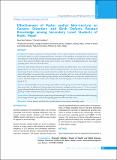Please use this identifier to cite or link to this item:
https://hdl.handle.net/20.500.14356/1408Full metadata record
| DC Field | Value | Language |
|---|---|---|
| dc.contributor.author | Pokhrel, Babu Ram | - |
| dc.contributor.author | Adhikari, Chiranjivi | - |
| dc.date.accessioned | 2023-05-10T06:50:46Z | - |
| dc.date.available | 2023-05-10T06:50:46Z | - |
| dc.date.issued | 2019 | - |
| dc.identifier.citation | PokhrelB. R., & AdhikariC. (2019). Effectiveness of Poster and/or Mini-Lecture on Genetic Disorders and Birth Defects Related Knowledge among Secondary Level Students of Kaski, Nepal. Journal of Nepal Health Research Council, 17(3), 331-335. https://doi.org/10.33314/jnhrc.v17i3.1795 | en_US |
| dc.identifier.issn | Print ISSN: 1727-5482; Online ISSN: 1999-6217 | - |
| dc.identifier.uri | http://103.69.126.140:8080/handle/20.500.14356/1408 | - |
| dc.description | Original Article | en_US |
| dc.description.abstract | Abstract Background: Almost seven percent of disease burden is due to genetic disorders and birth defects and they are associated to genetic as well as environmental factors. Prevention of such problems by making aware and increasing knowledge level with the help of health education during adolescence is cost-effective among others. In this context, current study proposed whether mini-lecture and/or poster is/are effective in changing adolescents’ knowledge regarding genetic disorders and birth defects. Methods: Mini-lectures followed by posters on genetic disorders and birth defects were used for intervention group, whereas for control, only mini-lectures based on health promotion were delivered by trained personnel in nine through 12 grade students of conveniently selected two public schools of Kaski district using quasi-experimental design. Knowledge was assessed using a pretested inventory at baseline, after two weeks of mini-lectures and two more weeks after poster for intervention group, whereas, only at baseline and two weeks after mini-lectures for control. Statistical analysis was carried out to compare the intervention group of 133 students with that of control group of 154. Results: Mean knowledge increments among control and intervention groups were 0.20 and 0.68 points respectively after mini-lecture. An addition of 0.84 points gained after the poster, yielding overall increment of 1.52 in intervention group. Inferential analysis showed that effect of control was not effective (p=0.60), whereas mini-lecture (p=0.032), poster (p=0.008) and both mini-lecture and poster (p<0.001) were effective. Conclusions: The mini-lecture and/or poster for grade nine through 12 are effective methods and media for bringing about changes in knowledge of adolescents regarding genetic disorders and birth defects. Keywords: Genetic disorder and birth defect; health education; intervention; knowledge; nepal. | en_US |
| dc.language.iso | en | en_US |
| dc.publisher | Nepal Health Research Council | en_US |
| dc.relation.ispartofseries | July-Sep, 2019;1795 | - |
| dc.subject | Genetic disorder and birth defect | en_US |
| dc.subject | Health education | en_US |
| dc.subject | Intervention | en_US |
| dc.subject | Knowledge | en_US |
| dc.subject | Nepal | en_US |
| dc.title | Effectiveness of Poster and/or Mini-Lecture on Genetic Disorders and Birth Defects Related Knowledge among Secondary Level Students of Kaski, Nepal | en_US |
| dc.type | Journal Article | en_US |
| local.journal.category | Original Article | - |
| Appears in Collections: | Vol. 17 No. 3 Issue 44 Jul-Sep 2019 | |
Files in This Item:
| File | Description | Size | Format | |
|---|---|---|---|---|
| 1795-Manuscript-12205-1-10-20191114.pdf | Fulltext Download | 247.63 kB | Adobe PDF |  View/Open |
Items in DSpace are protected by copyright, with all rights reserved, unless otherwise indicated.
